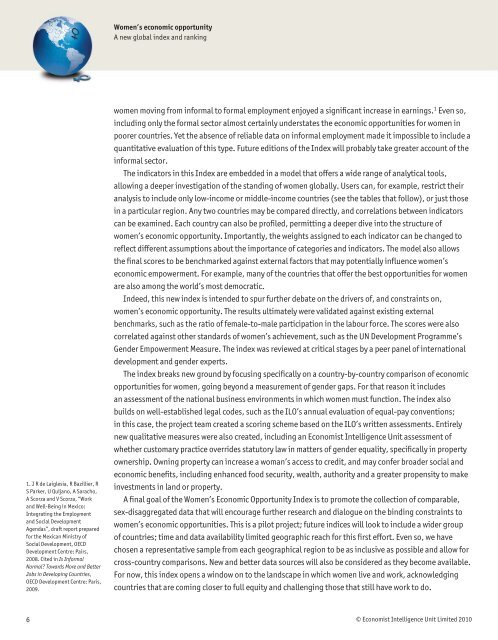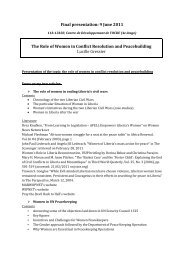Women's Economic Opportunity Index - Economist Intelligence Unit
Women's Economic Opportunity Index - Economist Intelligence Unit
Women's Economic Opportunity Index - Economist Intelligence Unit
- No tags were found...
You also want an ePaper? Increase the reach of your titles
YUMPU automatically turns print PDFs into web optimized ePapers that Google loves.
Women’s economic opportunityA new global index and ranking1. J R de Laiglesia, R Bazillier, RS Parker, U Quijano, A Saracho,A Scorza and V Scorza, “Workand Well-Being in Mexico:Integrating the Employmentand Social DevelopmentAgendas”, draft report preparedfor the Mexican Ministry ofSocial Development, OECDDevelopment Centre: Pairs,2008. Cited in Is InformalNormal? Towards More and BetterJobs in Developing Countries,OECD Development Centre: Paris,2009.women moving from informal to formal employment enjoyed a significant increase in earnings. 1 Even so,including only the formal sector almost certainly understates the economic opportunities for women inpoorer countries. Yet the absence of reliable data on informal employment made it impossible to include aquantitative evaluation of this type. Future editions of the <strong>Index</strong> will probably take greater account of theinformal sector.The indicators in this <strong>Index</strong> are embedded in a model that offers a wide range of analytical tools,allowing a deeper investigation of the standing of women globally. Users can, for example, restrict theiranalysis to include only low-income or middle-income countries (see the tables that follow), or just thosein a particular region. Any two countries may be compared directly, and correlations between indicatorscan be examined. Each country can also be profiled, permitting a deeper dive into the structure ofwomen’s economic opportunity. Importantly, the weights assigned to each indicator can be changed toreflect different assumptions about the importance of categories and indicators. The model also allowsthe final scores to be benchmarked against external factors that may potentially influence women’seconomic empowerment. For example, many of the countries that offer the best opportunities for womenare also among the world’s most democratic.Indeed, this new index is intended to spur further debate on the drivers of, and constraints on,women’s economic opportunity. The results ultimately were validated against existing externalbenchmarks, such as the ratio of female-to-male participation in the labour force. The scores were alsocorrelated against other standards of women’s achievement, such as the UN Development Programme’sGender Empowerment Measure. The index was reviewed at critical stages by a peer panel of internationaldevelopment and gender experts.The index breaks new ground by focusing specifically on a country-by-country comparison of economicopportunities for women, going beyond a measurement of gender gaps. For that reason it includesan assessment of the national business environments in which women must function. The index alsobuilds on well-established legal codes, such as the ILO’s annual evaluation of equal-pay conventions;in this case, the project team created a scoring scheme based on the ILO’s written assessments. Entirelynew qualitative measures were also created, including an <strong>Economist</strong> <strong>Intelligence</strong> <strong>Unit</strong> assessment ofwhether customary practice overrides statutory law in matters of gender equality, specifically in propertyownership. Owning property can increase a woman’s access to credit, and may confer broader social andeconomic benefits, including enhanced food security, wealth, authority and a greater propensity to makeinvestments in land or property.A final goal of the Women’s <strong>Economic</strong> <strong>Opportunity</strong> <strong>Index</strong> is to promote the collection of comparable,sex-disaggregated data that will encourage further research and dialogue on the binding constraints towomen’s economic opportunities. This is a pilot project; future indices will look to include a wider groupof countries; time and data availability limited geographic reach for this first effort. Even so, we havechosen a representative sample from each geographical region to be as inclusive as possible and allow forcross-country comparisons. New and better data sources will also be considered as they become available.For now, this index opens a window on to the landscape in which women live and work, acknowledgingcountries that are coming closer to full equity and challenging those that still have work to do.6© <strong>Economist</strong> <strong>Intelligence</strong> <strong>Unit</strong> Limited 2010




